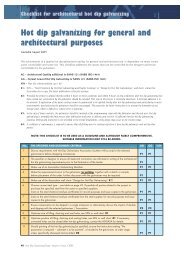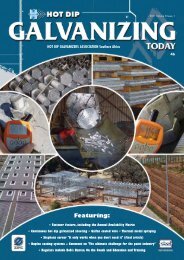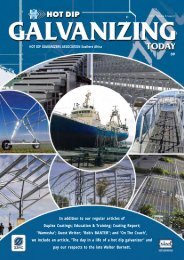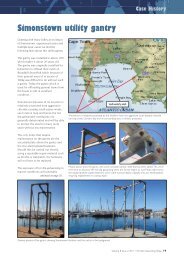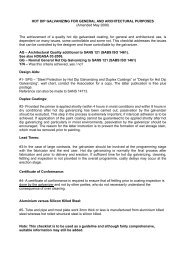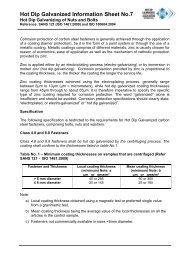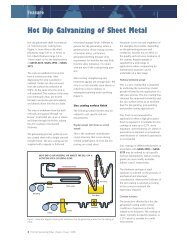Download - hdgasa
Download - hdgasa
Download - hdgasa
Create successful ePaper yourself
Turn your PDF publications into a flip-book with our unique Google optimized e-Paper software.
Duplex coatings<br />
© Stichting Zinkinfo Benelux. Photo by: G. Schmittmann, Amerongen<br />
© G. Reimerink, Amersfoort Photo by: G. Reimerink, Amersfoort.<br />
It is impossible to obtain a duplex system of<br />
sufficient quality on hot dip coatings like<br />
this.<br />
Day to day surface abrasion damages the outer<br />
powder coating.<br />
The customer and the galvanizer must<br />
agree on the condition of the galvanized<br />
surface before the pretreatment for<br />
powder coating begins. It is sometimes<br />
possible for a galvanizer to prepare a<br />
galvanized product for coating, although<br />
this may influence the cost. An example<br />
is a classification of the result of<br />
preparation for coating into ‘industrial’,<br />
‘decorative or ‘premium’ surface<br />
condition with appropriately increasing<br />
prices. Clear arrangements must be<br />
made also who, the galvanizer or the<br />
coater will prepare product for coating.<br />
Clear agreements are also needed for<br />
packaging of the products for delivery.<br />
The customer must make the<br />
© Stichting Zinkinfo Benelux<br />
© G. Reimerink, Amersfoort Photo by: G. Reimerink, Amersfoort.<br />
Only one layer of powder coating will not last<br />
long particularly if it is exposed to an aggressive<br />
marine atmosphere.<br />
Even when the powder coating is damaged the<br />
steel substrate is protected by the zinc, both from<br />
a barrier and cathodic protection perspective.<br />
requirements clear in the order with<br />
attention being paid to the ends of<br />
components, angles and projecting<br />
parts. These are easily damaged.<br />
Fabrication<br />
For long term performance and good<br />
appearance it is important that the hot<br />
dip galvanizing process produces a<br />
relatively smooth surface. Therefore the<br />
grade of steel used must not be one<br />
that has a tendency to cause rough or<br />
excessively thick zinc coatings. Timely<br />
attention to quality when purchasing<br />
steel is required. Any surface<br />
unevenness tends to be highlighted by<br />
an organic coating.<br />
Welding also requires extra attention.<br />
Welds must be sufficiently robust to<br />
cope with hot dip galvanizing, but also<br />
not be irritatingly visible after<br />
galvanizing. The selection of good<br />
welding materials and efficient cleaning<br />
of the welds are required. The welds<br />
must be smooth and meet level D of EN<br />
ISO 5817.<br />
Burrs and sharp points must be removed<br />
as effectively as possible. Sharp edges<br />
must be removed by grinding, cutting or<br />
milling. Rounding off to a radius of 2mm<br />
is the norm here. This is hardly possible<br />
with perforated plate and therefore<br />
account must be taken of the probable<br />
shorter service life of a duplex system.<br />
Hot dip galvanizing<br />
Products are air cooled after removal<br />
from the molten zinc bath, not<br />
quenched. This prevents the formation of<br />
brittleness in the zinc layer as well as<br />
potential adhesion problems of the<br />
powder coating.<br />
During preparation for coating, any sharp<br />
projections, welding residues, hard zinc<br />
and zinc beads must be removed. The<br />
zinc coating must however remain intact,<br />
so abrading or grinding down to the<br />
steel surface must be avoided. Areas of<br />
damage reaching the steel surface may<br />
only be repaired if the customer agrees.<br />
The method used must also be agreed,<br />
because not all repair methods will be<br />
compatible with the specified organic<br />
system. Repair can also be done after<br />
using abrasive paper to remove<br />
projecting steel splinters.<br />
Any additional requirements stated in<br />
the galvanizing standard (e.g. EN-ISO<br />
1461) must also be observed. The<br />
galvanizer must make sure that if the<br />
zinc bath composition deviates<br />
significantly from the norm,<br />
compatibility with the organic systems is<br />
investigated. It is advisable to contact<br />
the powder supplier about this.<br />
Storage, packing and transport<br />
Dry storage is preferable to prevent the<br />
formation of zinc corrosion products<br />
(wet storage stain). If storage does take<br />
place outside, good ventilation<br />
between components is essential.<br />
12 Hot Dip Galvanizing Today Volume 9 Issue 2 2012



